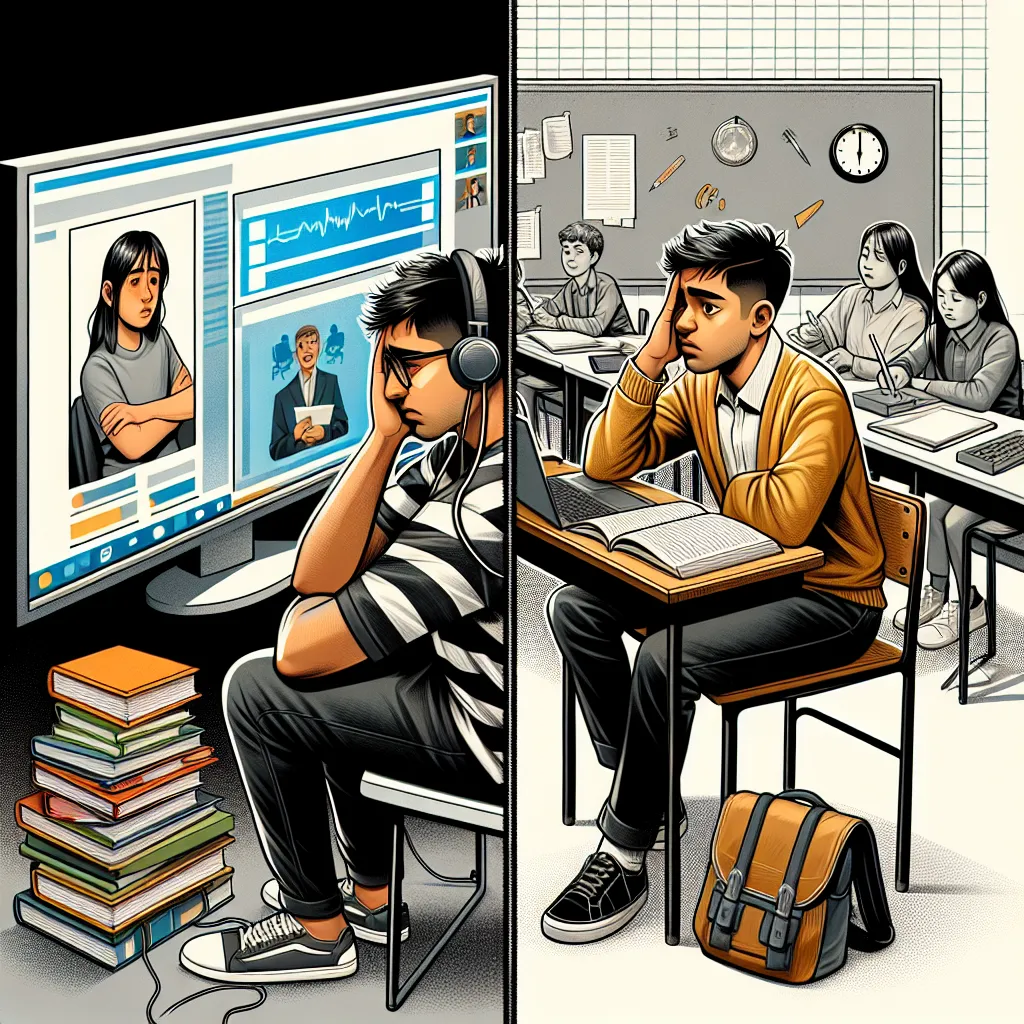Welcome to our IELTS Reading practice session focused on the timely topic of “The Impact of Remote Learning on Student Well-being.” As an experienced IELTS instructor, I’ve crafted this comprehensive practice test to help you sharpen your reading skills while exploring this crucial subject. Let’s dive into the passages and questions that mirror the actual IELTS Reading test format.
Nội dung bài viết
- Passage 1 (Easy Text)
- The Shift to Remote Learning
- Questions 1-7
- Questions 8-10
- Passage 2 (Medium Text)
- Psychological Impacts of Remote Learning on Students
- Questions 11-15
- Questions 16-20
- Passage 3 (Hard Text)
- The Multifaceted Impact of Remote Learning on Student Well-being: A Comprehensive Analysis
- Questions 21-26
- Questions 27-30
- Questions 31-35
- Answer Key
- Passage 1
- Passage 2
- Passage 3
 Impact of remote learning on student well-being
Impact of remote learning on student well-being
Passage 1 (Easy Text)
The Shift to Remote Learning
The COVID-19 pandemic has catalyzed an unprecedented shift in education worldwide, propelling millions of students into remote learning environments. This sudden transition has profoundly impacted various aspects of student life, particularly their overall well-being. While remote learning offers flexibility and continuity in education during challenging times, it also presents unique challenges that affect students’ mental, emotional, and physical health.
One of the most significant impacts of remote learning on student well-being is the reduced social interaction. The classroom environment traditionally provides students with opportunities to engage with peers, develop social skills, and build meaningful relationships. However, the virtual setting often limits these crucial interactions, potentially leading to feelings of isolation and loneliness. Many students report missing the camaraderie and support they once enjoyed in physical classrooms.
Moreover, the increased screen time associated with remote learning has raised concerns about its effects on physical health. Extended periods spent in front of computers or tablets can lead to eye strain, poor posture, and reduced physical activity. This sedentary lifestyle may contribute to various health issues, including obesity and musculoskeletal problems, if not properly managed.
On the flip side, remote learning has offered some positive impacts on student well-being. The flexibility in scheduling and learning pace can reduce stress for some students, allowing them to balance their studies with other responsibilities more effectively. Additionally, for students who previously experienced anxiety in traditional classroom settings, the remote environment may provide a more comfortable space for learning and participation.
However, the impact of remote learning on academic performance and motivation varies among students. While some thrive in self-directed learning environments, others struggle with the lack of structure and immediate feedback typically provided in traditional classrooms. This disparity can lead to increased stress and anxiety about academic progress and future prospects.
As educational institutions continue to navigate the challenges of remote learning, it is crucial to implement strategies that support student well-being. This may include incorporating regular breaks, promoting physical activity, facilitating virtual social interactions, and providing mental health resources. By addressing these aspects, educators and policymakers can work towards creating a more balanced and supportive remote learning experience for students.
Questions 1-7
Do the following statements agree with the information given in the passage? Write
TRUE if the statement agrees with the information
FALSE if the statement contradicts the information
NOT GIVEN if there is no information on this
- The COVID-19 pandemic has led to a significant increase in remote learning globally.
- Remote learning has only negative impacts on student well-being.
- Social interaction in virtual classrooms is equivalent to that in physical classrooms.
- Extended screen time in remote learning can cause physical health problems.
- All students find remote learning more stressful than traditional classroom learning.
- Remote learning provides a more comfortable environment for students with classroom anxiety.
- Educational institutions are not concerned about student well-being in remote learning settings.
Questions 8-10
Complete the sentences below. Choose NO MORE THAN TWO WORDS from the passage for each answer.
- The flexibility of remote learning allows some students to better balance their studies with other _____.
- Students who excel in _____ learning environments may perform better in remote learning settings.
- To support student well-being, educators should consider implementing strategies such as regular breaks and promoting _____.
Passage 2 (Medium Text)
Psychological Impacts of Remote Learning on Students
The transition to remote learning, while necessary during global health crises, has precipitated a range of psychological impacts on students across various educational levels. These effects, both positive and negative, have reshaped the learning experience and significantly influenced students’ mental health and overall well-being.
One of the most prominent psychological challenges faced by students in remote learning environments is the sense of isolation. The physical separation from peers and teachers can lead to feelings of disconnection and loneliness. This isolation can be particularly detrimental to adolescents and young adults, for whom social interactions play a crucial role in development and identity formation. The lack of face-to-face communication may hinder the development of social skills and emotional intelligence, potentially impacting students’ future personal and professional relationships.
Moreover, the blurring of boundaries between home and school life has created additional stress for many students. The home environment, once a sanctuary from academic pressures, has been transformed into the primary learning space. This shift can make it challenging for students to “switch off” from their studies, leading to increased anxiety and difficulty in maintaining a healthy work-life balance. The constant presence of academic responsibilities within the home setting may contribute to heightened stress levels and burnout.
Another significant psychological impact is the increased autonomy in learning management. While this can be empowering for some students, enhancing their sense of responsibility and self-discipline, it can be overwhelming for others. The need for self-motivation and time management in a less structured environment can lead to procrastination, decreased productivity, and subsequently, feelings of guilt and inadequacy. This disparity in adaptation to self-directed learning can exacerbate existing inequalities in academic performance and mental well-being.
The reduction in physical activity, often an inadvertent consequence of remote learning, also has psychological implications. Regular exercise and outdoor activities are known to have positive effects on mental health, helping to reduce stress and improve mood. The sedentary nature of remote learning, coupled with potential restrictions on outdoor activities during lockdowns, may contribute to increased rates of depression and anxiety among students.
However, it’s important to note that remote learning has also brought about some positive psychological impacts. For students who previously experienced social anxiety or bullying in traditional school settings, the online environment can provide a sense of safety and reduced stress. Additionally, the flexibility of remote learning allows some students to better align their learning schedules with their natural circadian rhythms, potentially improving focus and cognitive performance.
The impact on self-esteem and academic confidence is another crucial aspect to consider. Some students may experience a boost in confidence as they master new technologies and demonstrate adaptability in the face of change. Conversely, others may struggle with the technological demands or feel less capable without the immediate support and feedback available in a physical classroom, leading to diminished self-esteem.
As remote learning continues to be a significant part of the educational landscape, it is crucial for educators, parents, and mental health professionals to be aware of these psychological impacts. Implementing strategies to mitigate the negative effects while capitalizing on the positive aspects is essential. This may include creating virtual spaces for social interaction, providing robust mental health support services, and teaching stress management and time organization skills tailored to remote learning environments.
Furthermore, fostering a sense of community and belonging in virtual classrooms can help combat feelings of isolation. Regular check-ins, group projects, and online extracurricular activities can maintain social connections and support students’ emotional well-being. Encouraging a balanced approach to screen time and promoting physical activity, even within the constraints of home-based learning, is also crucial for maintaining good mental health.
In conclusion, while remote learning presents significant psychological challenges for students, it also offers opportunities for growth and adaptation. By understanding and addressing both the positive and negative impacts, educational institutions can work towards creating a more supportive and psychologically healthy remote learning experience for all students.
Questions 11-15
Choose the correct letter, A, B, C, or D.
-
According to the passage, one of the main psychological challenges of remote learning is:
A) Increased academic pressure
B) Difficulty in using technology
C) A sense of isolation
D) Lack of physical exercise -
The blurring of boundaries between home and school life has resulted in:
A) Improved work-life balance
B) Increased stress and anxiety
C) Better time management skills
D) Enhanced focus on studies -
For some students, increased autonomy in remote learning has led to:
A) Improved academic performance
B) Better social skills
C) Feelings of empowerment
D) Procrastination and decreased productivity -
The passage suggests that the reduction in physical activity due to remote learning:
A) Has no impact on mental health
B) Improves cognitive performance
C) May contribute to depression and anxiety
D) Enhances students’ focus on studies -
Which of the following is mentioned as a positive psychological impact of remote learning?
A) Increased social interaction
B) Reduced stress for students with social anxiety
C) Improved physical health
D) Enhanced teacher-student relationships
Questions 16-20
Complete the summary below. Choose NO MORE THAN TWO WORDS from the passage for each answer.
Remote learning has significant psychological impacts on students. While it can lead to feelings of (16) and stress due to the blurring of home and school boundaries, it also offers increased (17) in learning management. The reduction in (18) can negatively affect mental health. However, for some students, remote learning provides a sense of (19) and reduced stress. To mitigate negative effects, educators should implement strategies such as creating virtual spaces for social interaction and providing robust (20) _____ support services.
Passage 3 (Hard Text)
The Multifaceted Impact of Remote Learning on Student Well-being: A Comprehensive Analysis
The global shift towards remote learning, precipitated by the COVID-19 pandemic, has engendered a paradigm shift in educational methodologies and student experiences. This transition has profound implications for student well-being, encompassing psychological, social, physical, and academic dimensions. As educational institutions grapple with the challenges and opportunities presented by this new learning landscape, it is imperative to conduct a nuanced examination of its multifaceted impact on students.
From a psychological perspective, remote learning has introduced a complex interplay of factors affecting students’ mental health. The spatial and temporal dissociation from traditional learning environments has disrupted established routines and social structures, potentially leading to increased stress, anxiety, and feelings of isolation. The home environment, now doubling as an educational space, may not always be conducive to learning, exacerbating existing inequalities and creating new psychological pressures. Conversely, for some students, particularly those who previously experienced social anxiety or bullying in physical school settings, remote learning has provided a sanctuary, alleviating certain stressors associated with in-person interactions.
The social implications of remote learning are equally significant. The attenuation of face-to-face interactions has fundamentally altered the social fabric of educational experiences. While digital platforms offer alternative means of communication, they often fail to fully replicate the nuanced, spontaneous interactions that occur in physical settings. This deficit in social engagement can impede the development of crucial interpersonal skills and emotional intelligence. However, it has also catalyzed innovative forms of digital socialization and collaboration, potentially preparing students for an increasingly digitized global workforce.
Physical well-being, often overlooked in discussions of remote learning, has been significantly impacted. The sedentary nature of online education, coupled with increased screen time, poses risks to students’ physical health. Prolonged periods of sitting, often in ergonomically suboptimal conditions, can lead to musculoskeletal issues. Moreover, the reduction in incidental physical activity, typically associated with commuting to school and moving between classes, may contribute to a more sedentary lifestyle. This physical inactivity not only affects bodily health but also has cascading effects on cognitive function and mental well-being.
Academically, the impact of remote learning on student well-being is multifaceted and varies considerably among individuals. For some, the flexibility and autonomy offered by remote learning have enhanced their ability to manage their educational journey, leading to increased engagement and academic success. This environment has fostered self-directed learning skills, potentially better preparing students for higher education and professional settings that value independent work. Conversely, others have struggled with the lack of structure and immediate feedback characteristic of traditional classroom settings. The digital divide, exacerbated by socioeconomic disparities, has further complicated this landscape, potentially widening achievement gaps.
The metacognitive aspects of remote learning also warrant consideration. The shift to online platforms has necessitated the development of new learning strategies and digital literacy skills. While this adaptation can be challenging, it also presents opportunities for enhancing students’ metacognitive abilities, encouraging them to reflect on and optimize their learning processes. This self-awareness and adaptability are invaluable skills in an ever-evolving educational and professional landscape.
Furthermore, the impact of remote learning on student well-being must be contextualized within broader societal changes. The pandemic has not only altered educational methodologies but has also reshaped family dynamics, economic circumstances, and social norms. These broader changes inevitably influence students’ experiences of remote learning and their overall well-being. For instance, familial financial stress or health concerns may compound the challenges associated with remote education.
As we navigate this new educational terrain, it is crucial to adopt a holistic approach to supporting student well-being in remote learning environments. This approach should encompass psychological support, social engagement initiatives, physical health promotion, and academic assistance. Implementing synchronous and asynchronous learning modalities, fostering virtual communities, and providing resources for physical and mental health are key strategies in this endeavor.
Moreover, the role of educators in this new paradigm cannot be overstated. Teachers must not only adapt their pedagogical approaches but also serve as facilitators of student well-being. This expanded role requires professional development and support to equip educators with the necessary skills to identify and address the diverse needs of students in remote settings.
In conclusion, the impact of remote learning on student well-being is complex and multifaceted, presenting both challenges and opportunities. As we continue to navigate this educational shift, it is imperative to remain adaptive, responsive to student needs, and committed to fostering a holistic approach to education that prioritizes well-being alongside academic achievement. By doing so, we can work towards creating a more resilient, inclusive, and effective educational system that prepares students not just academically, but holistically for the challenges of the future.
Questions 21-26
Complete the sentences below. Choose NO MORE THAN TWO WORDS from the passage for each answer.
-
The transition to remote learning has disrupted established routines and social structures, potentially leading to increased _____ and feelings of isolation.
-
Digital platforms offer alternative means of communication but often fail to fully replicate the _____ interactions that occur in physical settings.
-
The sedentary nature of online education, coupled with increased _____, poses risks to students’ physical health.
-
For some students, the flexibility and autonomy offered by remote learning have enhanced their ability to manage their _____, leading to increased engagement and academic success.
-
The shift to online platforms has necessitated the development of new learning strategies and _____ skills.
-
Implementing _____ learning modalities is a key strategy in supporting student well-being in remote learning environments.
Questions 27-30
Do the following statements agree with the claims of the writer in the passage? Write
YES if the statement agrees with the claims of the writer
NO if the statement contradicts the claims of the writer
NOT GIVEN if it is impossible to say what the writer thinks about this
-
Remote learning has only negative impacts on students’ psychological well-being.
-
The digital divide has the potential to widen achievement gaps in remote learning settings.
-
All students have successfully adapted to the metacognitive aspects of remote learning.
-
Educators play a crucial role in facilitating student well-being in remote learning environments.
Questions 31-35
Choose the correct letter, A, B, C, or D.
-
According to the passage, which of the following is NOT mentioned as an impact of remote learning on student well-being?
A) Psychological effects
B) Social implications
C) Physical health concerns
D) Improved family relationships -
The passage suggests that remote learning has:
A) Universally improved students’ social skills
B) Completely eliminated bullying in educational settings
C) Provided a less stressful environment for some students with social anxiety
D) Increased face-to-face interactions among students -
The author argues that the physical impact of remote learning:
A) Is limited to musculoskeletal issues
B) Has no effect on cognitive function
C) Is often overlooked in discussions
D) Has improved students’ overall health -
Regarding the academic impact of remote learning, the passage states that:
A) All students have benefited equally
B) It has universally enhanced self-directed learning skills
C) The impact varies considerably among individuals
D) It has eliminated all achievement gaps -
The passage concludes that the approach to supporting student well-being in remote learning should be:
A) Focused solely on academic achievement
B) Holistic, encompassing various aspects of well-being
C) Limited to psychological support
D) Centered on returning to traditional classroom settings
Answer Key
Passage 1
- TRUE
- FALSE
- FALSE
- TRUE
- FALSE
- TRUE
- FALSE
- responsibilities
- self-directed
- physical activity
Passage 2
- C
- B
- D
- C
- B
- isolation
- autonomy
- physical activity
- safety
- mental health
Passage 3
- stress
- spontaneous
- screen time
- educational journey
- digital literacy


